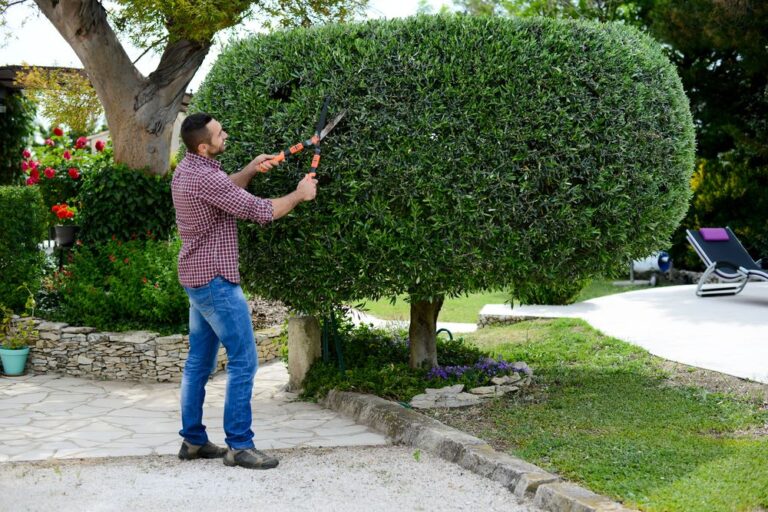How to Trim Fruit Trees for Better Yield
Any garden would benefit from fruit trees, which offer great produce, shade, and beauty. Regular trimming is crucial, nevertheless, to guarantee they produce the greatest fruits and develop well. This book will go over what you need to know about properly trimming fruit trees.
The Importance of Proper Pruning
Pruning fruit trees isn’t just about snipping branches. It’s a science and an art that keeps your trees healthy and productive. Proper pruning removes dead or diseased branches, shapes the tree for better sunlight exposure, and stimulates fruit growth.
The Benefits of Well-Pruned Fruit Trees
When you prune correctly, you can expect:
- Healthier Trees: Removing damaged or diseased branches helps the tree focus on healthy growth.
- Higher Yields: Correct trimming guides the tree’s energy into fruit generation instead of too much foliage.
- Improved Sunlight Penetration: Sunlight helps fruit on the tree ripens by reaching every part of it.
- Better Air Circulation: This reduces the risk of diseases and pests.

Understanding Basic Pruning Techniques
Pruning Cuts
- Heading Cut: By removing the terminal of a branch, a heading cut promotes fresh development below the cut. For young tree shape, this is quite helpful.
- Thinning Cut: Eliminating a whole limb or branch by a thinning cut increases air circulation and lessens crowding.
Timing of Pruning
- Dormant Pruning: Ideally done in late winter, when the tree is dormant, this kind of trimming promotes explosive spring development.
- Summer Pruning: Done in late summer, it lessens vigor than dormant pruning but controls development and enhances fruit quality.
Pruning for Different Fruit Trees
Pruning trees requirements vary throughout different trees. Here is a handbook including some typical fruit trees:
Apple Trees
- Training Young Trees: Beginning with cutting branches to build a robust structure, shape young apple trees. Emphasize on creating equally spaced side branches and a center leader—that of main vertical trunk.
- Maintaining Mature Trees: Take away crowded or dead branches. Thin the canopy to let the fruit be bathed in sunshine. Steer clear of too drastic cuts since this can lower fruit output.
Pear Trees
- Similar to Apple Trees: Since pear plants also gain from a strong central leader, they are pruned much as apple trees.
- Specific Considerations for Pear Trees: A bacterial disease, fire blight is common in pear plants. To stop disease spread, always sanitize your instruments both before and after pruning.
Cherry Trees
- Pruning for Fruit Production: Focus on removing dead or weak branches. Thin the tree to allow sunlight and air to circulate.
- Removing Water Sprouts and Suckers: Water sprouts—shoots rising vertically from branches—and suckers—shoots from the base of the tree—take energy from fruit production. Get rid of them right away.
Peach Trees
- Renewal Pruning: Peach trees produce fruit on one-year-old wood. Prune to remove old, unproductive branches and encourage new growth.
- Thinning Fruit: Thin the fruits to prevent overcrowding and allow the remaining fruits to grow larger and healthier.
Plum Trees
- Pruning for Shape and Productivity: Prune to keep your structure in vase form. This lets light and air through the tree, so encouraging improved fruit development.

Common Pruning Mistakes to Avoid
- Over-Pruning: Cutting too many branches at once can strain the tree and lower fruit output.
- Under-Pruning: Ignoring trimming could cause poor air circulation, crowding, and higher pest and disease risk.
- Incorrect Pruning Cuts: Steer clear of cutting too near to the trunk and leaving stubs. Both might damage the tree and cause delayed healing to stop.
- Neglecting Disease and Pest Control: While pruning, always check trees for indications of pests or diseases. Ignoring this could cause more major issues down road.
Tips for Healthy Fruit Trees
Pruning is important, but so is general tree maintenance. Combining these techniques will produce the finest effects:
- Fertilizing: To encourage good development and fruiting for your tree type, use the appropriate fertilizer.
- Watering: Make sure you water deeply consistently, particularly in dry seasons.
- Pest and Disease Management: Check trees often and address problems right once to stop them from spreading.
- Mulching: Around the tree’s base, mulch will help to control soil temperature, hold moisture, and fight weeds.
Tree Trimming Richmond
(804) 533-3943
https://treetrimmingrichmond.com/



